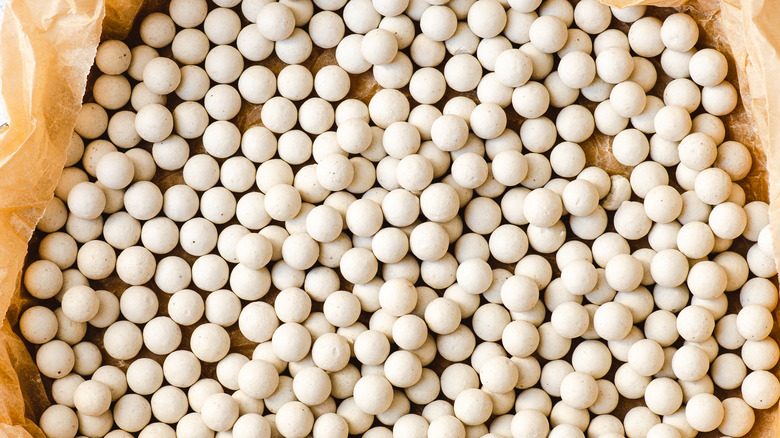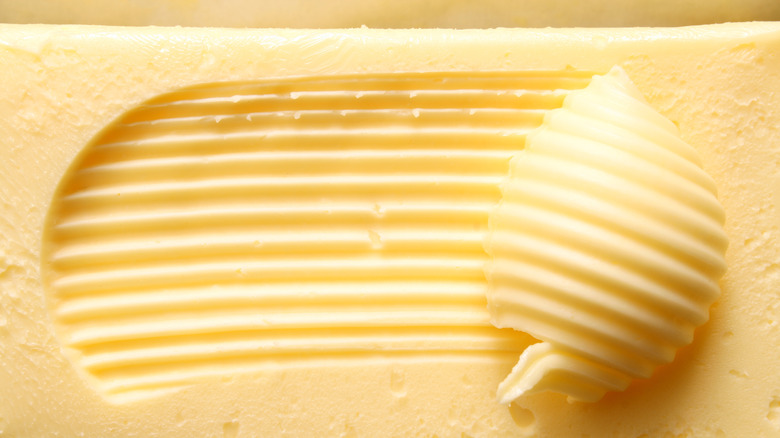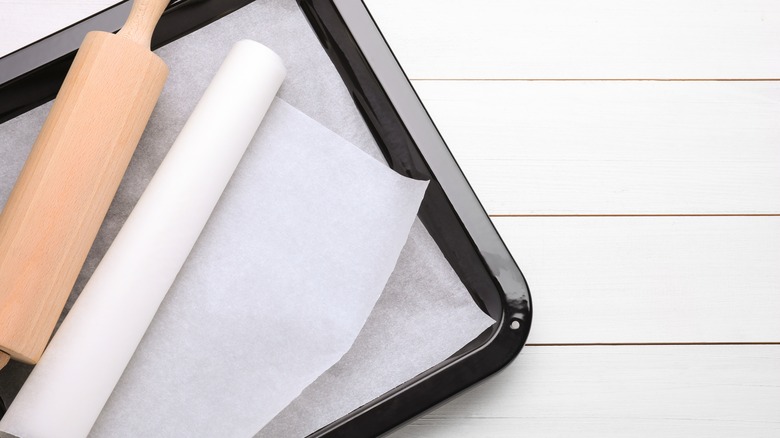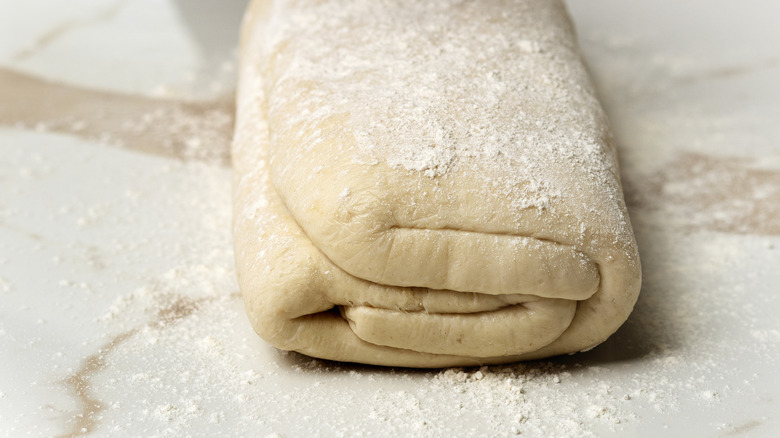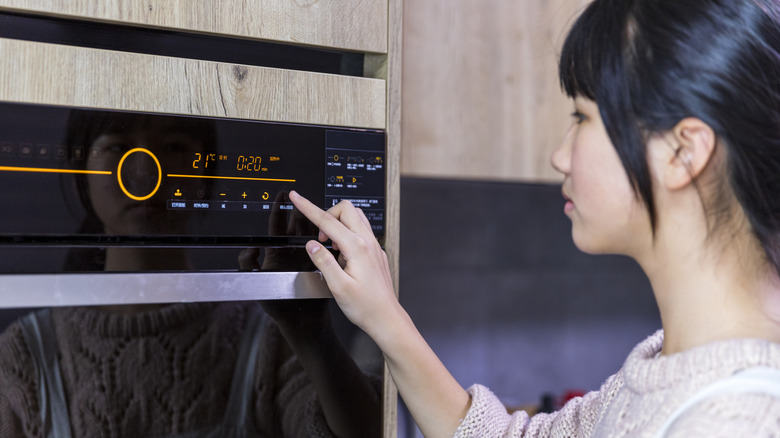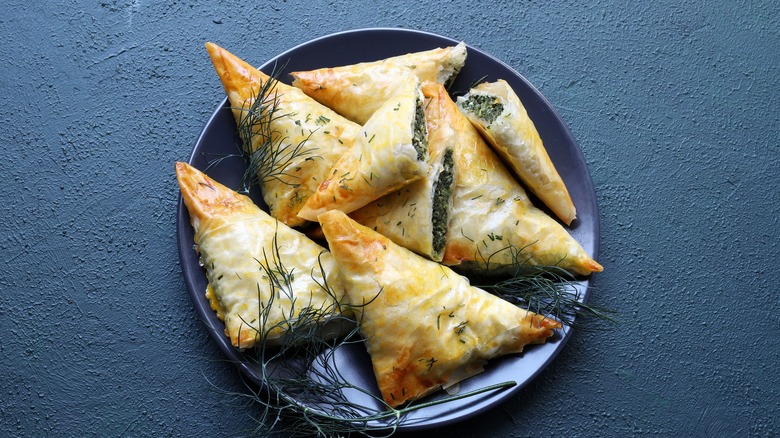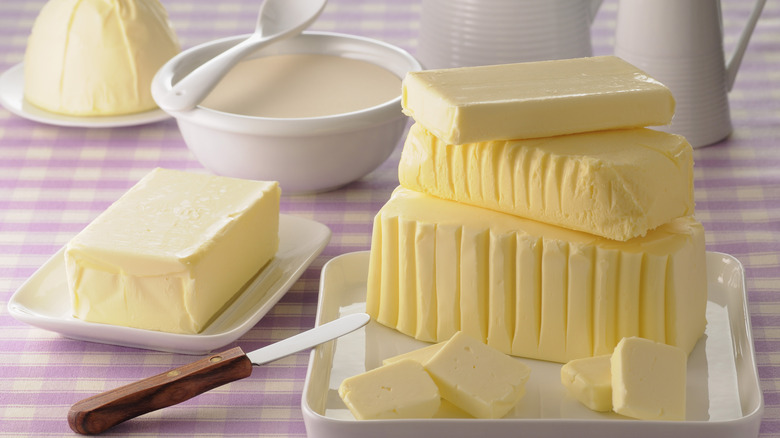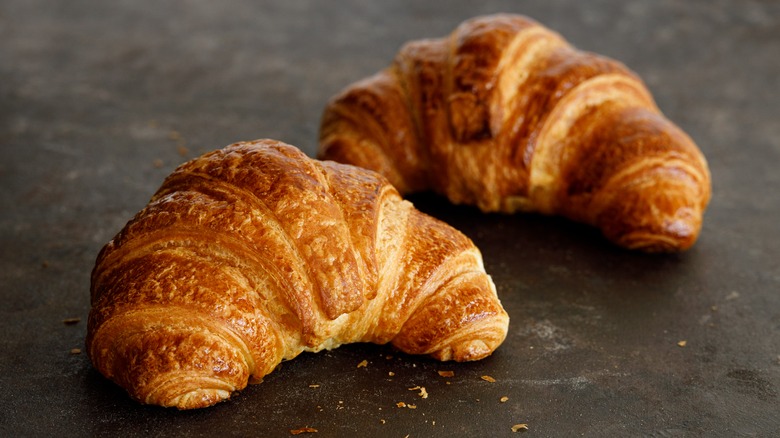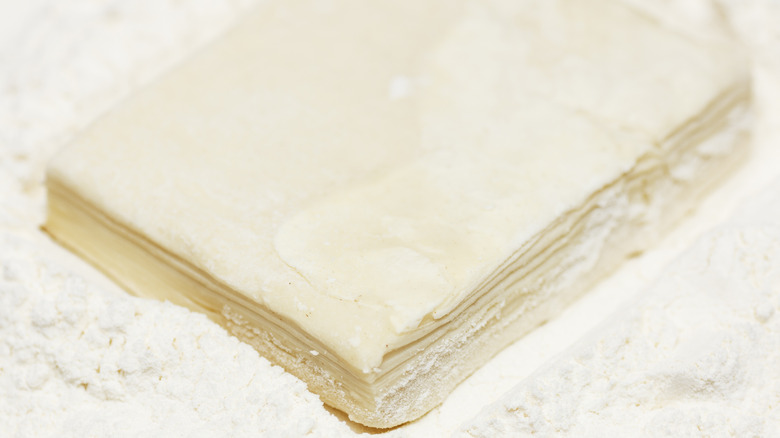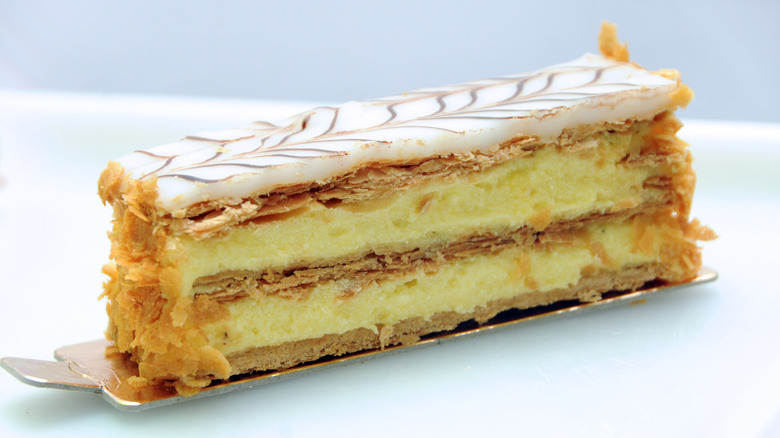14 Tips You Need For Making Puff Pastry, According To A Pastry Chef
You can't get through a couple of episodes of "The Great British Baking Show" without seeing at least one baker work with puff pastry. It's tantalizing to watch the contestants flip, turn, and laminate their dough with seemingly endless blocks of butter before popping it in the oven to get a beautiful, flaky creation.
And if amateur bakers do it, how hard can it be to make puff pastry at home and turn it into something worthy of national T.V.? The short answer? Very hard. To help ease your pastry woes, we've enlisted the help of Ann Kirk, pastry chef at Little Dom's in Los Angeles. She shared with us some of the most common mistakes people make with this finicky pastry and how to correct them. Even novice bakers who sheepishly grab a box of puff pastry from the grocery store can use many of these hacks to whip up defined layers that rise to the occasion.
Use pie weights for an even bake
Pie weights are an essential tool to have in the kitchen — especially if you consider yourself to be an avid pie baker. The weights are often used for blind baking, which allows the baker to crisp a crust ahead of time. This is particularly useful if the filling doesn't require that long of a bake (or no bake at all).
Pie weights are also essential if you're working with puff pastry. While the characteristic puff is important to whatever you're baking, too much puff can be detrimental if you're aiming for a flat, even — like for a tart. If you neglect to properly weigh down your puff pastry, you'll risk it coming out misshapen or with extra thick spots. Not only does this mess with its visual appeal, but it could potentially mean that some places are underbaked while others are overcooked.
You'll want to use your pie weights in the same way you would use them for your standard pie crust. First, prick the pastry with a fork or knife to create little steam vents before covering the base with a layer of foil or parchment and your pie weights.
Stick to an all-butter pastry
When you're looking at your puff pastry in the store, you won't just want to pick one with the most attractive label or price. You'll need to also check the ingredients list.
You should always use an all-butter puff pastry because it will give you the perfect puff. Butter has both water and fat, which will gradually steam as the puff pastry bakes and will give you a tall, crunchy pastry with defined layers. Butter also creates a unique mouthfeel that your shortening or hydrogenated-fat-based pastry can never get close to. It won't make your mouth feel oily or coat your tongue in a layer of grease.
Many folks also find butter-based puff pastry easier to work with because it isn't as likely to rip and tear as other varieties. While you can try to avoid tearing by coating your work surface in flour and ensuring that your pastry is entirely thawed out, these extra measures won't do you any good if you're working with a weak pastry.
Try baking your tarts upside-down for a better puff
We are grateful for many culinary tips dolled out by folks on TikTok. But this tip for excellent flaky tarts may be one of the app's very best.
Creators on the app have recommended that you try an upside-down pastry hack to achieve the perfect structure and consistency. You'll want to start by putting your tart toppings down onto a lined baking sheet before covering each with a layer of the delicious puff pastry. Press around the corners with a fork to seal the pastry and the toppings together. Once the pastry has cooled, you'll just need to flip the pan over to have a seemingly normal treat waiting for you.
Baking the tarts upside down has some benefits. Fruit toppings, including pineapple, can really benefit from having some time nestled up against a hot baking pan so they can caramelize. The toppings also won't weigh down the puff pastry, which will allow it to rise to its fullest potential.
Thaw it easily on a baking sheet
One of the most essential things you have to do when working with frozen puff pastry is to bring it up to room temperature before you cook it. But, sometimes, just plopping your box on the countertop just won't cut it. Chef Ann Kirk recommends thawing your puff pastry in the refrigerator instead of on the countertop. It will prevent the butter from getting too warm, and, as a result, less water will leak from the butter into the flour.
But not everyone has the time to wait for the crust to thaw in the fridge overnight. Instead, thaw your pastry at room temperature with the help of your baking sheet. Start by removing the dough from the box and separating the layers on your pan. You'll ideally want the pastry to be as thin as possible. Depending on the ambient temperature of your kitchen and the thinness of your pastry, you can have your pastry ready to go in just about 20 minutes. But it's always best to allocate a little bit of extra time just in case things don't go to plan — as often happens with baking. You'll know your puff pastry is ready to go when it's soft to the poke.
You should keep your baking sheet around for cooking your pastry, too. It's Kirk's go-to for baking pastry because it's made of conductive metal and can quickly cook the dough without causing the butter to leach out.
Avoid rolling to the edge
Laminating puff pastry isn't the only tricky step you'll encounter working with this ingredient. Rolling puff pastry can also be a challenge because you don't want to push all the butter out or warm the pastry up too much so that all of the butter leaches out. More importantly, when you roll out the sheets, you risk sealing the pastry into a thick log of dough that won't rise. When it comes to rolling out your pastry, skip rolling to the edges of the dough. Focus on the middle of the dough, instead.
In addition, you can also ensure that your dough gets a characteristic rise by using a sharp knife to cut through the pastry and prevent haphazard cuts. You can also opt for a metal bench scrapper, which will easily allow you to slice through the dough with the refined precision of a trained pastry chef.
Be wary of hot spots in your oven
If you notice only parts of your pigs in a blanket rose while others deflated like sad balloons, you should first examine your oven. The same can be said if you notice your pastries that are burnt on one side yet pale and soft on others. Your puff pastry may not have baked evenly because of your oven's hot spots.
Unfortunately, there are often not many ways to remedy oven hot spots — but there is power in knowing where exactly those spots are. You can use a parchment paper trick to map your oven's hot spots; layer a single piece of parchment paper on a baking sheet and ramp up the heat to 400 F. After 20 minutes, you can see the spots where the parchment is super brown, and where it is pale. For most ovens, the hottest spots are along the walls, top, and bottom of your oven. One solution to unevenly baked puff pastries is to rotate the pan during the baking process. You can also try to bake it on a center rack to encourage circulation around the pans.
Keep your oven temperature hot
We've all heard the cautionary tale of baking your oven before preheating it first. But making this temperature mistake with puff pastry can be a fatal one that will irreparably ruin your tart.
To understand why preheating is important for puff pastry, you first have to understand the science behind baking the layered dough. When the butter in the pastry melts, it releases steam and gives the recipe its iconic puff. If you bake at a low temperature or put your pastry in a cold oven and gradually bring the temperature up, you risk not reaching the critical point at which your butter steams. The butter will just seep out onto the baking tray or infuse with the dough layers, which creates a stodgy texture. Besides missing the mark for perfect structure, puff pastry that has been improperly baked also won't have that perfectly golden brown color.
The ideal threshold for baking puff pastry hovers around 400 F, but pastry chef Ann Kirk notes that you can go as high as 425 F. If you need to temper the heat of your oven or are looking for a paler pastry, you can always cover it with foil while it bakes. You'll still reach the perfect puff threshold but won't expose the pastry as much to the radiating heat.
Don't mistake it with other types of dough
One of the cardinal rules of baking is always to read your recipe before you start. It will ensure you have the perfect number of ingredients and that you won't need to make a trip to the grocery store before you pull out your mixer. In some cases, substitutions are appropriate. But others, like substituting puff pastry for phyllo dough is not.
Puff pastry is made by layering cold butter into laminated layers in the pastry. It's often used for sweet and savory dishes, like tarts, turnovers, and palmiers. Phyllo dough, on the other hand, is made using an entirely different process and doesn't feature butter as a primary structural component. Instead, it's made of very brittle sheets of dough, made with flour, water, vinegar, fat, and salt, that have been stacked into a singular piece. It's often used for treats like baklava and Green spanakopita.
Puff pastry is much sturdier and thicker than phyllo, so it can support denser toppings. If you use phyllo for your apple turnovers, you'll find that you won't get the perfect puff, and your treats will come out more like autumnal baklava — which we would still gladly like to sample.
Aim for a pastry made with European butter
There are so many different types of butter out there, so how do you go about choosing the "right" one? Butter varieties, like American, Irish, European, and Amish butter all have trace differences in butterfat content. While you might ask yourself what trivial difference 2% butterfat could have on the flavor and texture of a product, we can assure you that it's bigger than you'd think.
When selecting a frozen puff pastry, you should always aim for a pastry that contains European butter. This butter has about 82% butterfat, which is 2% more than the butter most Americans find in their local supermarket. European butter is ideal for pie crusts and pastries because it has a higher ratio of fat to water, which will leave your turnovers and tarts with a better butter flavor. Pastry chef Ann Kirk uses European butter for its profound flavor but notes that it is typically more expensive than standard American butter.
There are some occasions where American butter is better than European butter, but it's often for outside of the puff pastry world. For example, if you use European butter for a buttermilk biscuit, you'll find that the batch will come out drier because it needs the extra steam to get the proper structure and rise. But for slathering on a good piece of bread or making your own puff pastry at home, European butter is the way to go.
Don't think it's the same as croissant dough
At first glance, it's reasonable to assume that croissant dough and puff pastry are the same thing. After all, look at those perfectly discernable layers and buttery taste.
There are some minor differences between croissant dough and puff pastry. Both types of dough are considered laminated, which means they're stacked with cold butter and layers of dough to create the perfect puff. But croissant dough contains yeast and milk, which gives it a more tender consistency and makes it more fragile than puff pastry. Instead, the standard puff pastry's dough base is simple; it contains only flour, water, and salt, along with the layers of fat that give it the perfect puff. Both croissants and puff pastry are versatile, and you can stuff them with an array of fillings, including chocolate, feta, and veggies. But if you try to make your own croissants with puff pastry, know that the resulting pastry will not be the same.
Don't leave it out of the fridge for too long
Puff pastry needs to be baked in a hot, hot oven to ensure it gets the perfect puff. But this isn't the only setting where temperature matters. One of the biggest mistakes people make with puff pastry, pastry chef Ann Kirk notes, is not chilling the dough enough before putting it in the oven. If you leave your tarts on the counter for too long while you're prepping your fillings, you'll risk the butter warming up and fusing into the dough, which will turn it stodgy, gluey, and, worst of all, ill-risen. You can tell that you likely didn't chill your pastry enough if you take a peek in the oven and see your ball of dough floating in a butter puddle.
If you're making puff pastry at home, Kirk recommends popping it in the fridge in between turns to give your butter a chance to firm up. She also notes that working a sheet at a time in a cool kitchen can discourage the butter from melting. And even if you opt for the store-bought puff pastry, you should always put it back in the fridge for at least 10 minutes after shaping and before baking to ensure that your dough stays perfectly firm and buttery.
You don't have to make it yourself
The most important piece of advice we learned from Ina Garten is that store-bought is fine. Although it might feel very homey to whip up a homemade batch of croissants or puff pastry pinwheels for a dinner party, there is absolutely no reason to go through the aggravation of repeatedly shaping, laminating, rotating, and chilling your dough.
Former "Great British Baking Show" judge Mary Berry's puff pastry secret is that she just uses the store-bought version rather than meticulously folding and making her own, noting that she doesn't want to spend hours on the task. We're with you there, Mary. Pastry chef Ann Kirk says the same, noting that there's "no shame in buying one."
The best part about store-bought puff pastry is that you can keep it in your freezer until you need it, and it's relatively easy to refreeze the extras after it's thawed. You can have apple turnovers at a moment's notice, so as long as you have a box of quality puff pastry in your freezer.
Add your favorite seasonings to give it a creative twist
Puff pastry is one of the most versatile ingredients you can have tucked away in your freezer. For example, if you have a package of ranch seasoning, you can easily upgrade your puff pastry pinwheels. Sprinkle the seasoning in between your layers of dough, along with any additional flavorings and fillings, before folding it up, slicing the rounds, and baking it in the oven. It's an excellent complement to umami-rich cheeses like parmesan, or it can add some extra oomph to a batch of summery pesto pinwheels.
You can also add some savory goodness to your puff pastry treats with everything bagel seasoning. You can make a bagel twist on your pastries by adding a layer of cream cheese and topping it off with melted butter and a sprinkle of everything bagel seasoning on top. The seasoning, which includes sesame, sea salt, onions, and poppy seeds, is also excellent for any of your cheese-stuffed pastries, including a wheel of baked brie.
Get creative with it
Don't let yourself get stuck with boring turnovers or galettes; let your puff pastry rise to new heights with creative recipes. We recommend trying a show-stopper mushroom pithivier, which is essentially a massive mushroom pie encased with puff pastry. This recipe takes several hours to make and bake, but you can tweak it to add creative crust designs or make it entirely vegetarian. It's a beautiful side dish that you'll want to have on your holiday table.
Puff pastry and sweet ingredients are also a match made in heaven. You can make a Funfetti Napoleon cake – which is essentially a child-friendly version of the mille-feuille. The sheets of dough are layered with a sweetened mascarpone cream filling and sweet icing embellished with beautiful, colorful food coloring swirls. You don't even have to make your own puff pastry for this recipe; you'll just need one box of defrosted, store-bought pastry to make it.

